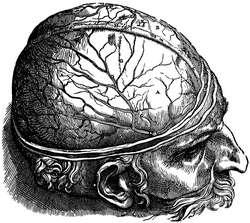| First used by Galen, the term [menynx] is Greek and means "membrane", referring initially to any body membrane. Erasistratus (c. 300 B.C.) used the term [menynx] to refer to a membrane covering of the brain and spinal cord and has been used so since then.
The plural form of [menynx] is [meninges]. The plural form is common, but the singular form [menynx] is usually used incorrectly as [meninge]. There are three meninges that cover the spinal cord and brain. From deep to superficial: •Pia Mater: Latin terms meaning "tender mother" it is a thin membrane covering the outer layer of the spinal cord and brain intimately and not easily dissectable from the organ. •Arachnoid mater: The term refers to the spider-web look of this vascular menynx. •Dura mater: Latin terms meaning "tough mother". The dura mater is the outermost layer and is quite tough, forming a sac containing the spinal cord and brain, the dural sac or thecal sac. The images depict two famous sketches by Andrea Vesalius. The superior image shows a head with the dura mater in situ (label "A"). The second image show the dura mater open (label "H") and the vessels associated with the arachnoid layer. Between the arachnoid mater and pia mater there is a "space" filled with fluid. The space is called the subarachnoid space and the fluid is the cerebrospinal fluid. Original images from Andreas Vesalius' "De Humani Corporis Fabrica; Libri Septem" (1543) |
  |
| MTD Main Page | Subscribe to MTD |